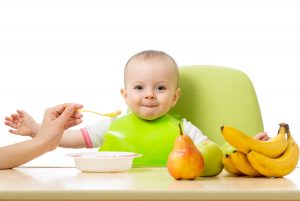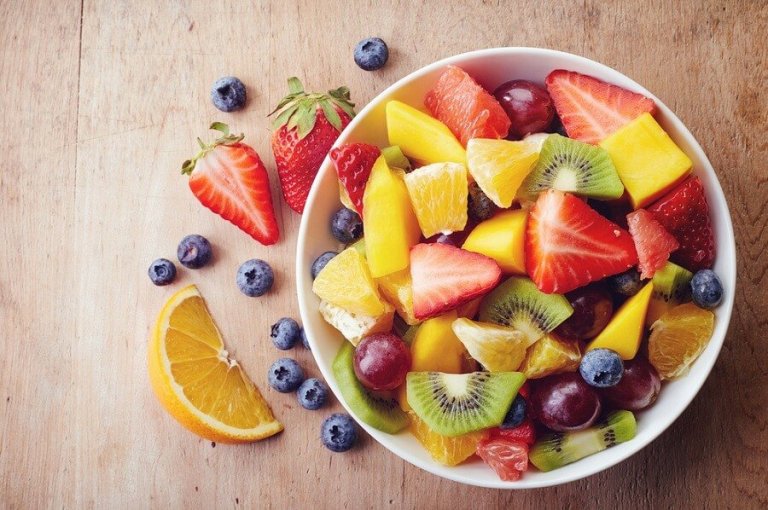How to Introduce Fruit in Your Child’s Diet?

If you’re about to introduce fruit in your child’s diet for the first time, read on to find some helpful tips.
Fruits provide numerous benefits to children whether they are consumed whole, in jam or in juices. Children should become familiar with fruit from an early age and get used to eating them without any additives.
Due to the high nutritional value that fruits have, they can be introduced to children even while they’re breastfeeding.
Fruits can be incorporated into a child’s diet in various forms such as juices, pulp, pastes, jam and jelly.
When fruits are ripe, they are easily digestible and can be eaten either raw or cooked.
Keep in mind that when you cook fruits, they lose a notable amount of minerals and nutrients. Therefore, the fruits’ nutritional value will be reduced.
Children have very delicate stomachs, so it’s best to give them cooked fruits. You can cook the fruits in a little bit of water. After the fruit is properly cooked, save the water, as they can drink it later.
The skin around the fruit is usually less digestible than the pulp, so they should eat peeled fruit.
In order to facilitate the process of introducing fruits into your child’s diet, we’ve prepared a few simple recipes that you can give your child even when they’re still breastfeeding:
Apple sauce
Ingredients
- 50 grams of grated apples
- 100 grams of tea water
- 50 grams of ringer serum (ringer can be found in pharmacies)
Preparation
- Put the apples in a puree press or a food processor and then mix with the other ingredients.
- Before serving the puree, heat it up a little and stir. Ready to be served!
There are fruits such as bananas and dried chestnuts which can be beneficial to a child’s diet. These fruits are rich in carbohydrates and low in fats and proteins.
Sugary fruits such as dates, grapes and figs have high nutritional value and they’re rich in minerals. Your children will be able to easily digest them in the form of jellies or juices.

Fruits such as melons and apricots contain lots of vitamins and they’re also juicy. Due to their high water content, they’re refreshing, alkalizing and purifying.
Pediatricians should be consulted before the incorporation of citric fruits such as oranges, lemons, passion fruits and pineapples. These fruits can trigger allergies. They’re usually only recommended after the child reaches the age of 18 months.
It’s important to introduce fruits during breakfast or right after breakfast. This way they’ll have all of the vitamins they’ll need during the day.
Recommended daily servings
Depending on the child’s vitamin intake, fruits should be consumed in the following portions:
- Banana: ½
- Melon: ½ cup cut into slices
- Watermelon: 1 portion of 6×4 centimeters
- Mango: 1 small piece
- Pear: ½
- Guava: ½
- Papaya: ½ cup cut into pieces
Remember that the fruit you provide for your child should depend on their age. That’s why it’s important to consult the child’s pediatrician.
It’s completely normal for the little one to reject the fruit or juice at first. This is simply because it’s a new taste that their palate will have to adapt to since they’ve only consumed break milk until now.
Fruit should only be introduced into a child’s diet after the age of 6 months.
When you’re going to introduce fruit into your child’s diet, avoid sugar until they reach the age of 12 months. Take advantage of the natural sugar found in the fruits you provide your children; you don’t have to add any processed sugar.
Sugar provides calories and for a child who is developing it can be very bad for the pancreas. Sugar can have disastrous consequences after a long period of time.
Therefore, fruits should be consumed without adding additives, especially during the first years of a child’s life.

Main benefits of fruits
Fruits provide many benefits, here are a few:
- They promote tissue development.
- The smell stimulates brain activity.
- Fruits help maintain healthy gums.
- They’re important for the proper functioning of nerves and muscles.
- Some fruits have laxative properties.
- They stimulate the secretion of saliva when chewed.
- Fruits regulate digestive activities.
- Their colors stimulate attention.
- They increase the concentration of red blood cells and they favor oxygenation.
In conclusion, introducing fruit into your child’s diet can provide numerous positive benefits.
If we as parents put into place the right measures, we’ll be creating very healthy habits that our children will keep for a lifetime.
If you’re about to introduce fruit in your child’s diet for the first time, read on to find some helpful tips.
Fruits provide numerous benefits to children whether they are consumed whole, in jam or in juices. Children should become familiar with fruit from an early age and get used to eating them without any additives.
Due to the high nutritional value that fruits have, they can be introduced to children even while they’re breastfeeding.
Fruits can be incorporated into a child’s diet in various forms such as juices, pulp, pastes, jam and jelly.
When fruits are ripe, they are easily digestible and can be eaten either raw or cooked.
Keep in mind that when you cook fruits, they lose a notable amount of minerals and nutrients. Therefore, the fruits’ nutritional value will be reduced.
Children have very delicate stomachs, so it’s best to give them cooked fruits. You can cook the fruits in a little bit of water. After the fruit is properly cooked, save the water, as they can drink it later.
The skin around the fruit is usually less digestible than the pulp, so they should eat peeled fruit.
In order to facilitate the process of introducing fruits into your child’s diet, we’ve prepared a few simple recipes that you can give your child even when they’re still breastfeeding:
Apple sauce
Ingredients
- 50 grams of grated apples
- 100 grams of tea water
- 50 grams of ringer serum (ringer can be found in pharmacies)
Preparation
- Put the apples in a puree press or a food processor and then mix with the other ingredients.
- Before serving the puree, heat it up a little and stir. Ready to be served!
There are fruits such as bananas and dried chestnuts which can be beneficial to a child’s diet. These fruits are rich in carbohydrates and low in fats and proteins.
Sugary fruits such as dates, grapes and figs have high nutritional value and they’re rich in minerals. Your children will be able to easily digest them in the form of jellies or juices.

Fruits such as melons and apricots contain lots of vitamins and they’re also juicy. Due to their high water content, they’re refreshing, alkalizing and purifying.
Pediatricians should be consulted before the incorporation of citric fruits such as oranges, lemons, passion fruits and pineapples. These fruits can trigger allergies. They’re usually only recommended after the child reaches the age of 18 months.
It’s important to introduce fruits during breakfast or right after breakfast. This way they’ll have all of the vitamins they’ll need during the day.
Recommended daily servings
Depending on the child’s vitamin intake, fruits should be consumed in the following portions:
- Banana: ½
- Melon: ½ cup cut into slices
- Watermelon: 1 portion of 6×4 centimeters
- Mango: 1 small piece
- Pear: ½
- Guava: ½
- Papaya: ½ cup cut into pieces
Remember that the fruit you provide for your child should depend on their age. That’s why it’s important to consult the child’s pediatrician.
It’s completely normal for the little one to reject the fruit or juice at first. This is simply because it’s a new taste that their palate will have to adapt to since they’ve only consumed break milk until now.
Fruit should only be introduced into a child’s diet after the age of 6 months.
When you’re going to introduce fruit into your child’s diet, avoid sugar until they reach the age of 12 months. Take advantage of the natural sugar found in the fruits you provide your children; you don’t have to add any processed sugar.
Sugar provides calories and for a child who is developing it can be very bad for the pancreas. Sugar can have disastrous consequences after a long period of time.
Therefore, fruits should be consumed without adding additives, especially during the first years of a child’s life.

Main benefits of fruits
Fruits provide many benefits, here are a few:
- They promote tissue development.
- The smell stimulates brain activity.
- Fruits help maintain healthy gums.
- They’re important for the proper functioning of nerves and muscles.
- Some fruits have laxative properties.
- They stimulate the secretion of saliva when chewed.
- Fruits regulate digestive activities.
- Their colors stimulate attention.
- They increase the concentration of red blood cells and they favor oxygenation.
In conclusion, introducing fruit into your child’s diet can provide numerous positive benefits.
If we as parents put into place the right measures, we’ll be creating very healthy habits that our children will keep for a lifetime.
All cited sources were thoroughly reviewed by our team to ensure their quality, reliability, currency, and validity. The bibliography of this article was considered reliable and of academic or scientific accuracy.
- Arvanitoyannis, I. S., Savva, M., & Dionisopoulou, N. K. (2012). Fruits. In Modified Atmosphere and Active Packaging Technologies. https://doi.org/10.1201/b12174
- WHO. (2015). WHO | Healthy diet. https://doi.org/10.4158/EP161365.GL
This text is provided for informational purposes only and does not replace consultation with a professional. If in doubt, consult your specialist.








